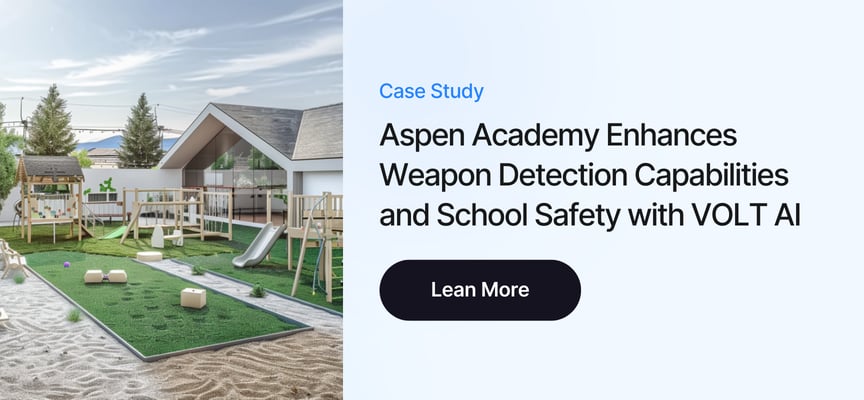Key Takeaways on Camera Placement Strategy
- Assessment-Driven Placement: Effective camera positioning starts with identifying your specific security vulnerabilities, high-value assets, and traffic patterns.
- Critical Coverage Points: Entry/exit points, high-value areas, and convergence zones should receive priority camera placement to maximize security effectiveness.
- Technical Optimization: Height, angle, lighting conditions, and environmental factors significantly impact camera performance regardless of location.
- Privacy-Security Balance: Strategic placement respects privacy in sensitive areas while maintaining comprehensive security through thoughtful positioning and policy.
- AI Enhancement: While placement remains important, AI-powered solutions like VOLT transform existing cameras into intelligent security assets regardless of their current positioning.
When it comes to video surveillance, where you place your cameras matters as much as which cameras you choose. Strategic camera placement transforms basic monitoring into comprehensive security coverage that deters threats, captures critical incidents, and provides valuable intelligence. While having advanced AI-powered cameras is important, their effectiveness ultimately depends on proper positioning throughout your facility.
The best camera placement addresses several factors: coverage requirements, privacy considerations, environmental conditions, and resource constraints. This guide examines the strategic decision-making behind effective camera placement, helping you maximize security outcomes while avoiding common mistakes that leave vulnerable gaps in your protection.
Read Now: How video monitoring is transforming with AI Powered Intelligence
Security Foundations — Let’s Talk Framework
Before determining camera locations, conduct a thorough security assessment that identifies your specific vulnerabilities and objectives. This assessment provides the foundation for all camera placement decisions.
.jpg?width=2256&height=997&name=Frame%201000004690%20(1).jpg)
Threat Analysis and Asset Identification
Start by identifying what you need to protect most. High-value assets, sensitive information, and areas with increased security risks should receive priority coverage. Different environments face different threats:
- Educational institutions prioritize entrance monitoring, common areas, and emergency exit pathways
- Healthcare facilities focus on medication storage, patient care areas, and visitor access points
- Residential communities emphasize package delivery areas, parking facilities, and perimeter access
- Commercial properties concentrate on inventory storage, point-of-sale systems, and employee-only zones
Document these priorities to guide your camera placement strategy, ensuring critical areas receive appropriate coverage while maximizing return on your security investment.
Traffic Flow Mapping
Understanding how people move through your facility reveals natural surveillance opportunities and potential blind spots. Map primary circulation paths, entry/exit points, and gathering areas to identify:
- High-traffic zones requiring wider-angle coverage
- Choke points where most people must pass
- Natural congregation areas where incidents often occur
- Isolated areas with limited visibility and oversight
This traffic analysis helps place cameras where they'll capture the most relevant activity while minimizing the number of cameras needed for comprehensive coverage.
.jpg?width=2256&height=1424&name=Thumbnail%20(41).jpg)
Strategic Exterior Camera Placements
Exterior surveillance forms your first line of defense, identifying threats before they enter your facility. Effective exterior placement requires balancing visibility, environmental factors, and coverage needs.
Entry and Exit Points
Every access point represents both a security necessity and potential vulnerability:
- Main entrances require cameras capturing clear facial images of everyone entering
- Secondary doors need coverage monitoring unauthorized access attempts
- Loading docks benefit from cameras monitoring both vehicle and personnel activity
- Emergency exits require surveillance to prevent unauthorized entry while ensuring safety compliance
- Vehicle gates need cameras capturing license plates and driver identification
Position cameras to capture both approach paths and the actual entry point, creating comprehensive coverage that follows subjects from initial approach through entry.
Perimeter Monitoring
Effective perimeter surveillance balances wide coverage areas with detailed monitoring of vulnerable points:
- Property boundaries benefit from cameras with wider fields of view
- Fence lines need strategic camera placement to eliminate blind spots
- Vulnerable access points require dedicated coverage with higher detail
- Parking areas need placement that captures vehicle and pedestrian movement patterns
For larger properties, consider camera placement that creates overlapping zones of coverage, ensuring no area remains completely unwatched. Many facilities use a combination of wide-area cameras supplemented by more focused cameras at critical points.
Visit the full video monitoring resource center
Critical Interior Camera Placements
Interior camera placement should focus on monitoring critical operations, protecting assets, and maintaining situational awareness throughout your facility.
High-Value Areas
Areas containing valuable assets or sensitive operations require dedicated coverage:
- Inventory storage benefits from comprehensive camera placement covering all access points
- Cash handling locations need detailed coverage capturing all transactions
- Server rooms and data centers require monitoring of all entry points and equipment access
- Restricted areas need cameras covering both the rooms themselves and approach corridors
Position cameras to capture clear images of anyone accessing these areas while maintaining complete coverage that eliminates blind spots where theft or tampering could occur undetected.
Common Areas and Convergence Zones
Places where people naturally gather present both security challenges and surveillance opportunities:
- Lobbies and reception areas need cameras capturing everyone entering the facility
- Elevators and stairwells benefit from placement that monitors both entry and interior activity
- Break rooms and cafeterias require strategic placement that respects privacy while maintaining security
- Hallway intersections provide natural monitoring points covering multiple corridors
These areas often serve as ideal camera locations because they naturally capture significant activity while minimizing the total number of cameras needed.
.jpg?width=2256&height=1424&name=Thumbnail%20(42).jpg)
Technical Considerations for Optimal Placement
Beyond location strategy, several technical factors significantly impact camera effectiveness:
Mounting Height and Angle
The physical positioning of cameras directly affects image quality and coverage area:
- Height considerations: Position cameras 8-10 feet high for optimal balance between overview and detail
- Angle optimization: Avoid extreme up/down angles that distort facial features
- Counter-measures awareness: Position cameras to minimize vulnerability to tampering or obstruction
- Coverage overlap: Ensure adjacent cameras provide some overlapping coverage to eliminate blind spots
These technical details often make the difference between usable security footage and missed opportunities during incidents.
Lighting and Environmental Factors
Environmental conditions dramatically impact camera performance:
- Lighting evaluation: Assess natural and artificial lighting throughout the day/night cycle
- Backlight considerations: Avoid positioning cameras facing bright light sources or windows
- Weather exposure: For exterior cameras, consider protection from rain, snow, and temperature extremes
- Seasonal changes: Account for how seasonal lighting and foliage changes might affect visibility
These environmental factors require thoughtful planning and sometimes specialized camera selection to ensure consistent performance regardless of conditions.
Balancing Security and Privacy Concerns
Effective surveillance must balance security needs with privacy expectations and legal requirements:
Privacy-Sensitive Areas
Certain locations require special consideration due to privacy implications:
- Restrooms and changing areas should never have camera coverage inside
- Break rooms and resting areas benefit from selective coverage of entry points only
- Office spaces should focus on general areas rather than individual workstations
- Residential areas in multi-family properties should avoid direct views into private dwellings
Respecting these privacy boundaries while maintaining security requires thoughtful camera positioning and sometimes the use of privacy masks that block sensitive areas from view.
Notification and Transparency
Most jurisdictions require notification of video surveillance:
- Signage requirements: Post clear notices in monitored areas
- Policy documentation: Maintain transparent surveillance policies
- Access controls: Restrict footage access to authorized personnel
- Retention limits: Establish appropriate data retention periods
These practices not only ensure legal compliance but also maximize the deterrent effect of your surveillance system while building trust with those in monitored areas.

Implementation Best Practices
Successfully implementing your camera placement strategy requires methodical planning and execution:
Phased Deployment Approach
Rather than attempting to install all cameras simultaneously, consider a phased approach:
- Priority coverage: Begin with highest-risk areas and critical assets
- Core operations: Expand to operational areas and main circulation paths
- Secondary coverage: Add cameras to address remaining vulnerabilities
- Optimization phase: Fine-tune placement based on performance evaluation
This approach allows you to allocate resources effectively while learning from early implementation experiences to improve later phases.
Documentation and Mapping
Maintain comprehensive documentation of your camera system:
- System map: Create detailed schematics showing camera locations and coverage zones
- Technical specifications: Document model information, settings, and maintenance requirements
- Testing results: Record field-of-view validations and performance benchmarks
- Maintenance schedule: Establish regular testing and cleaning protocols
This documentation proves invaluable for system maintenance, troubleshooting, and future expansions.
Enhancing Camera Placement with VOLT AI
Strategic camera placement provides the foundation for effective surveillance, but AI-powered video intelligence exponentially increases its value. VOLT AI transforms traditional camera systems into proactive security assets by adding:
- Real-time threat detection across all camera feeds simultaneously
- Cross-camera tracking that follows subjects throughout your facility
- Behavioral analysis that identifies suspicious activities before they escalate
- 3D facility mapping that displays security information in spatial context
- Customizable detection rules tailored to your specific security concerns
Our system works with your existing cameras, regardless of where they're positioned, enhancing their capabilities without requiring replacement. By layering AI intelligence onto your current camera infrastructure, VOLT AI maximizes the effectiveness of your surveillance system while minimizing additional investment.
Strategic Camera Placement: Maximizing Security Coverage
Thoughtful camera placement transforms basic surveillance into comprehensive security that deters threats and provides actionable intelligence. By conducting thorough assessments, prioritizing critical areas, and balancing security with privacy considerations, you create a surveillance system that truly protects what matters most with fewer resources.
Remember that optimal placement isn't about installing more cameras—it's about strategic positioning that maximizes coverage while eliminating blind spots. This approach creates more effective security while optimizing your investment.
Ready to transform your existing cameras into an intelligent security system? Schedule a demo with VOLT to discover how our AI-powered platform can enhance your current camera infrastructure, regardless of placement, to create a more effective security operation that proactively protects your facility.




.jpg?width=2256&height=1424&name=Thumbnail%20(40).jpg)


